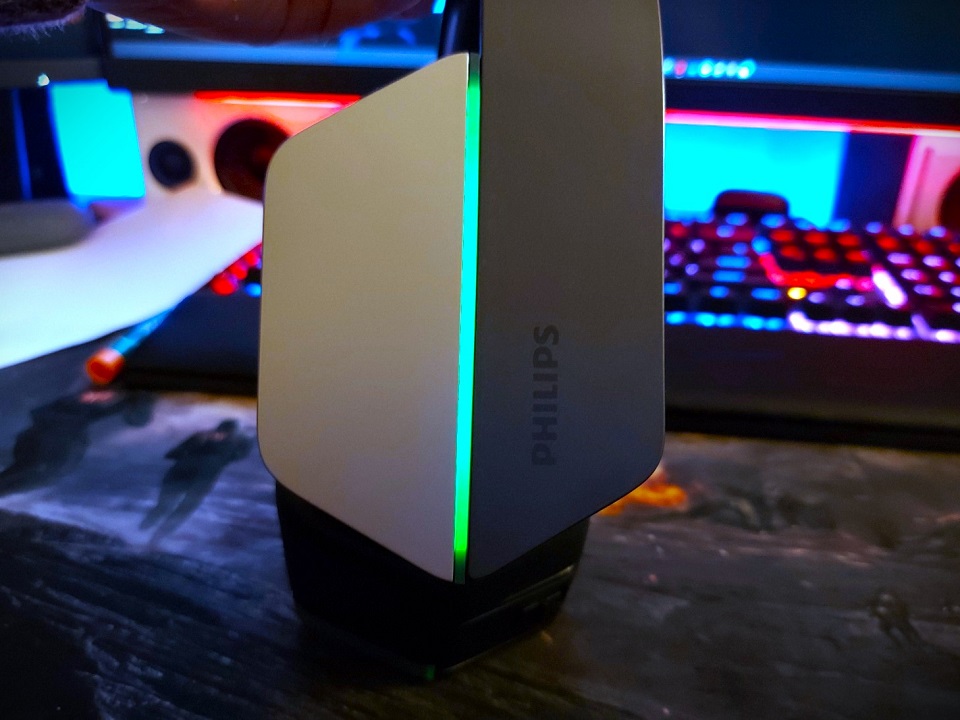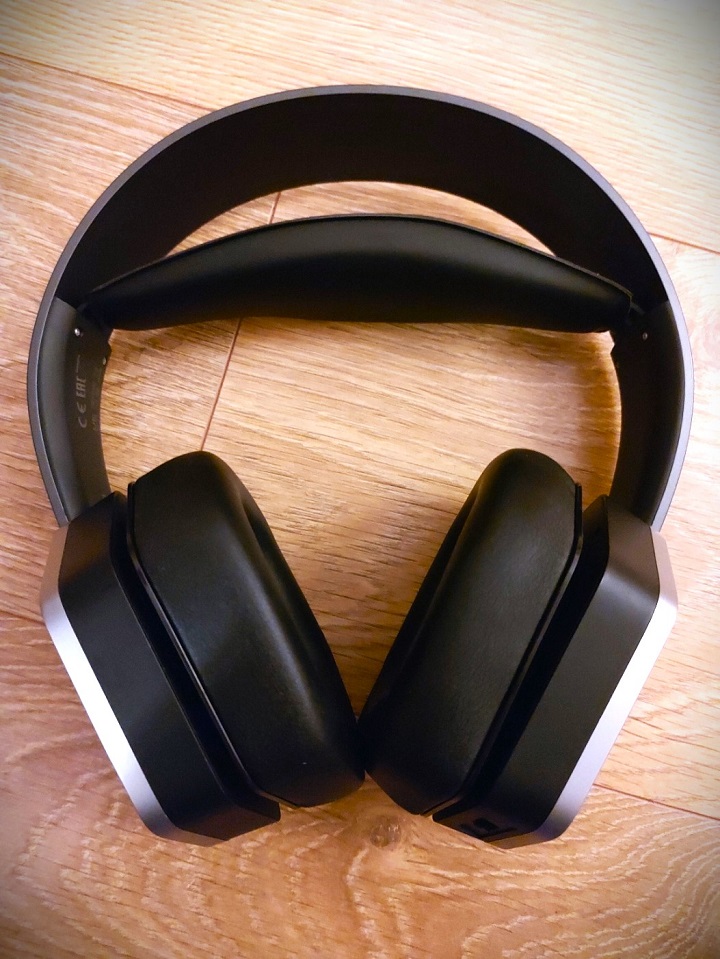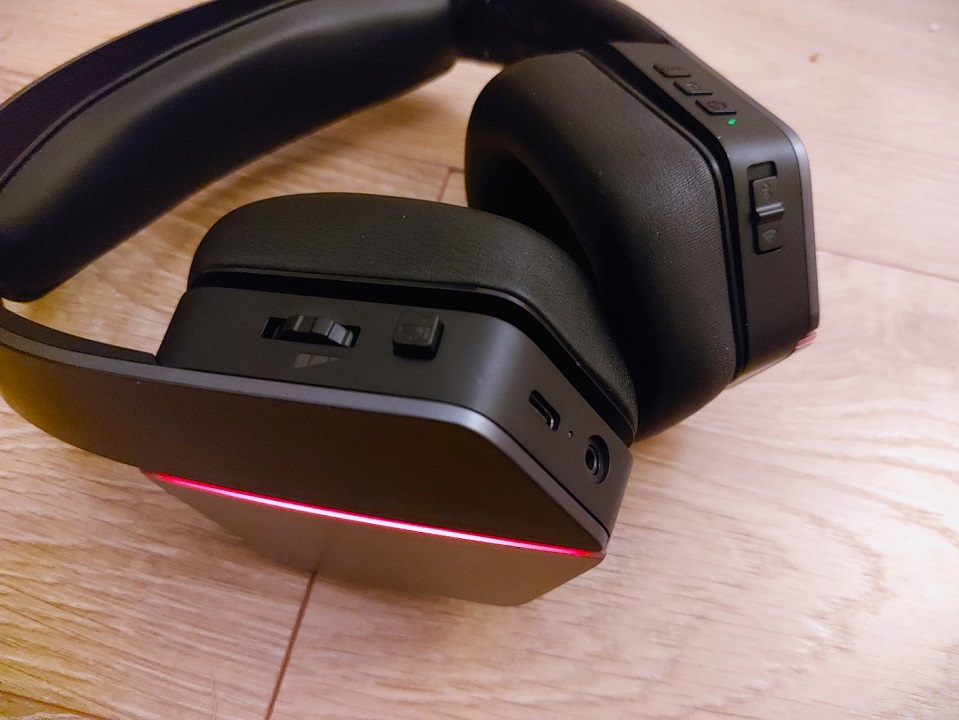Philips’ TAG5106 sports great sound quality and a raft of desirable features, but fitment issues limit its potential
- Manufacturer: Philips
- Model: TAG5106
- Type: Dual-wireless (Bluetooth/2.4GHz) gaming headset
- Price: £79 MSRP
- Supported Connections: 2.4GHz wireless (via dongle), Bluetooth 5.2
- Reviewed on: Windows PC, Samsung Mobile/Tablet
- Supplied by: Philips

Philips TAG5106 Review
Overview
The Philips TAG5106 is a dual-wireless headset that supports both Bluetooth 5.2 and 2.4 GHz connectivity, though it cannot use both simultaneously. Additionally, it features a 3.5mm audio jack, making it compatible with a huge range of devices.
This oversized headset neatly matches the aesthetic of Philips’ Momentum range, with a tasteful colourway and subtle RGB. The sound quality is very good, particularly considering the price point. However, a few design decisions have had a negative impact on fitment, which in turn affects the sound quality.
Design and build
What’s in the box?
- Orbit wireless earphones
- USB-C to USB-C charging cable
- Charging case
- Quick-start guide/user manual
- Campfire Audio pin-badge
- Memory foam and silicon tips (S/M/L)
The TAG 5106 shares a lot of design similarities with the soon-to-be-released Evnia range, but it retains the gun-metal/dark grey colourway that fans of Philips’ Momentum range will be instantly familiar with. Vertically split two-tone colouring is divided by a bright RGB light strip separating the two elements. It’s a bold look and one that I’m fully here for.
While RGB is often overused in gamer products, on the TAG5106, it serves as an understated accent that gives it a premium feel. However, it is very restricted in its implementation, with only static red, green, or blue colour options available, or a breathing mode that cycles through the three colours. The option to specify a colour would have been preferable, as it would enable you to tie it into your own custom aesthetic. It can also be switched off completely, which improves battery life by a significant amount.

The TAG5106 features a lot of plastic in its construction, but it feels fairly durable and has a pleasant finish, with no creaking joins when flexing the headset. However, the switches feel a little clunky, and their assignment and placement aren’t very intuitive.
Although the TAG5106 is on the large side, comfort isn’t an issue; the suspended headband rests gently on your head, and the earcups are snug without being constraining. However, the lack of rotation and limited pivot on the earcups, along with the offset chassis/headband that sits towards the back of the earcups, means that you have to wear the headset further back on your head.
Unfortunately, the clamping force isn’t sufficient. Because the lower end of the headset straightens out, this holds the bottom of the ear cups outwards and prevents the TAG5106 from covering the bottom of your ears which stops it from creating an effective acoustic seal.
I tried repositioning them, but I couldn’t get a proper seal without holding in the bottom of the headset. It’s also quite a loose fit; turn your head sharply and you can physically feel the headset swinging on your head, which in turn affects the sound further, causing the lower frequencies to wash in and out. This creates significant sound leakage that effectively undoes all the hard work Philips’ engineers have done to create the otherwise clear and focused sound.

Connectivity, features and controls
In terms of connectivity and features, the TAG5106 is well-equipped and simple to use. The headset can be switched between Bluetooth and 2.4GHz modes with a simple switch, and connecting via the 3.5mm audio jack will override both wireless connections. However, the 2.4GHz connection can be a bit awkward to set up, as the dongle doesn’t ship paired with the headset, requiring a manual pairing process.
During testing, the headset became unpaired twice, and the pairing button on the dongle was difficult to press due to its location, especially when plugged into my monitor’s USB hub. Once connected, the 2.4GHz connection was stable with no dropouts and the average range was as we’d expect, staying connected at a distance of around four meters from the dongle (through thick 1950s walls), which is consistent with other headsets I’ve tested. The latency of the 2.4GHz connection was very good at under 50ms, compared to the approximately 140ms latency of the Bluetooth connection. I would note that the Bluetooth latency, though higher than the 2.4 GHz connection, is still what I would consider better than usual, and caused no issues with audio/lip-sync.
Bluetooth is more reliable in maintaining a connection over larger distances, reaching nearly 7 metres (I was outside my house by this point), but sadly there’s no Bluetooth multipoint support. If you want to connect to a new Bluetooth device, the TAG5106 will enter pairing mode each time it’s turned on, but only if it’s out of range of a previously paired device. Other wireless devices I’ve tested can be physically put into pairing mode, which is far more convenient than disconnecting or turning off Bluetooth on the most recent device each time. Realistically, most users won’t be swapping and changing devices as frequently as I was during testing, but the awkwardness makes it worth mentioning.
When using the headset in Bluetooth mode paired to your phone, the power button also operates as a multi-function button, with a single tap used to play/pause music and answer/hang up calls, and double or triple tapping skips to the next or previous track, respectively.
The rest of the controls on the TAG5106 include a simple button to toggle between breathing and static modes for the RGB lighting, a push-in/out toggle to mute the microphone, and a scroll wheel to control the volume. However, it’s worth noting that the volume wheel is not tied to the system or device volume, and operates as an independent adjustment. There’s also a DTS toggle for surround sound, which is only operational via the 2.4GHz wireless connection. However, you can use your device’s native surround sound features via Bluetooth or wired connections.

Sound Quality
As mentioned, the fitment negatively affects the performance of the TAG5106, which is disappointing, because it actually produces quality audio. The audio tune is clearly designed for gamers, and for this, it excels. Reminiscent of the super-human hearing modes available from other manufacturers, the native audio has a definite focus on the mids and treble, and a decent soundstage gives suitable width to this headset creating a tangible benefit in multiplayer games where directional cues are key.
The bass is well-represented and able to produce low-down rumble, but considering the large drivers it lacks a little oomph. This extends across all of the bass frequencies and lowest mids – it’s remarkably clean, and retains plenty of desirable definition without booming, which is great for gaming. Still, it feels a little underwhelming for movies and music. This gives the TAG5106 exceptional clarity, but at the expense of warmth.
The mids in the TAG5106 come through very cleanly, although the lower end, like the bass, could benefit from some boosting. This can make vocals sound a bit less natural, but it does a good job of accentuating gunfire and allowing team communications to come through very clearly without getting lost in the mix.
The headset’s crisp treble blends smoothly into the mids and is bright without being piercing, making it comfortable for prolonged gaming sessions.
If I were to describe the sound of the TAG5106 in one word, it would be “clinical”. The headset produces very precise audio that is well-suited for competitive gaming, but it lacks warmth and may not be ideal for other listening purposes such as music or movies. However, if you are primarily interested in gaming, the TAG5106 could be a great option, especially considering its affordable price.
Unfortunately, the fitment issues with the headset significantly impact its audio performance. The bass, which is already somewhat underwhelming, becomes almost completely lost due to the lack of seal. This results in a hollow, disconnected sound, which was a common issue experienced by multiple people who tried the headset. A greater amount of pivot in the earcups or a more traditional fork design could have helped prevent this issue, but as it stands, the TAG5106 may be a difficult product to recommend.


Battery life
Remarkably, the Philips TAG5106 can last over 45 hours with the RGB switched off, dropping to a still respectable 35 hours with RGB on. Recharging via the now ubiquitous USB-C port takes just 2 hours. This is a vast improvement over wireless headsets from just a year or two ago, which often needed charging daily.
Summary
The Philips TAG5106 is a fully featured headset, with a few minor niggles that can generally be overlooked. It has wide compatibility thanks to multiple connection options, the design is rather fetching (and I love the RGB strip), the sound has the potential to be ideal for competitive gaming, and the battery life is outstanding. However, the imperfect fit that ruins the acoustic seal will be a deal-breaker for most.
It’s so disappointing, as just a few minor changes to the design would have made this headset easy to recommend, especially for the price. If you can try one, and the headset fits your head without losing the seal, you’re going to be very happy with it. Based on my sample group’s experience, though, it’s a rare miss for Philips.

